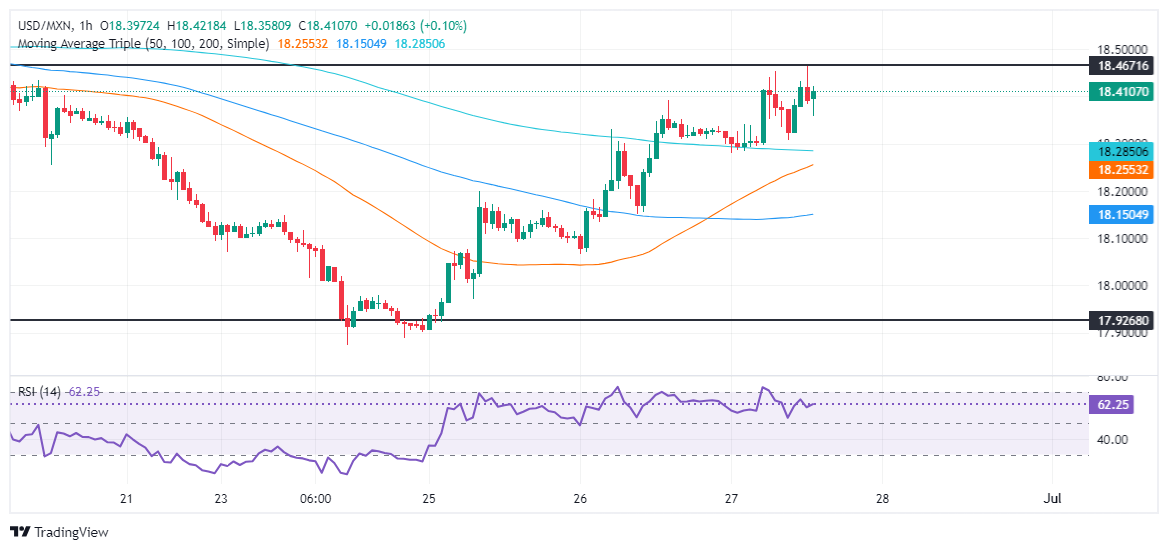- Analytics
- News and Tools
- Market News
- Banxico keeps rates at 11.00%, Peso continues to depreciate
Banxico keeps rates at 11.00%, Peso continues to depreciate
- Banxico holds interest rate at 11.00%; Deputy Gov. Mejia Castelazo votes for 25 bps cut.
- Officials cite financial market volatility and unique economic factors in Mexico.
- USD/MXN dips to 18.35 post-Banxico, then climbs, gaining 0.42%.
On Thursday, the Bank of Mexico (Banxico) decided to hold the overnight interbank interest rate at 11.00%, as expected by most market participants. However, the decision was not unanimous, with Deputy Governor Omar Mejia Castelazo's 25-basis-point rate cut vote potentially having a significant impact.
Banxico's unanimous decision fails to underpin the Mexican Peso
Banxico policymakers mentioned that Mexico's financial markets were volatile and affected by “idiosyncratic factors.” Consequently, Mexico’s Government bond yields rose, and the Peso depreciated.
Officials mentioned that the disinflation process is expected to continue, adding that “the board foresees that the inflationary environment may allow for discussing reference rate adjustments.”
They acknowledged that the Mexican Peso depreciation impacted inflation forecasts, which were offset by weaker economic activity; however, the inflation risks balance remains skewed to the upside.
USD/MXN Reaction to Banxico’s Decision
The USD/MXN retreated to 18.35, before resuming its ongoing uptrend, with momentum favoring buyers, as depicted by the Relative Strength Index (RSI) in the hourly chart. The exotic pair trades with gains of 0.42%.
Banxico FAQs
The Bank of Mexico, also known as Banxico, is the country’s central bank. Its mission is to preserve the value of Mexico’s currency, the Mexican Peso (MXN), and to set the monetary policy. To this end, its main objective is to maintain low and stable inflation within target levels – at or close to its target of 3%, the midpoint in a tolerance band of between 2% and 4%.
The main tool of the Banxico to guide monetary policy is by setting interest rates. When inflation is above target, the bank will attempt to tame it by raising rates, making it more expensive for households and businesses to borrow money and thus cooling the economy. Higher interest rates are generally positive for the Mexican Peso (MXN) as they lead to higher yields, making the country a more attractive place for investors. On the contrary, lower interest rates tend to weaken MXN. The rate differential with the USD, or how the Banxico is expected to set interest rates compared with the US Federal Reserve (Fed), is a key factor.
Banxico meets eight times a year, and its monetary policy is greatly influenced by decisions of the US Federal Reserve (Fed). Therefore, the central bank’s decision-making committee usually gathers a week after the Fed. In doing so, Banxico reacts and sometimes anticipates monetary policy measures set by the Federal Reserve. For example, after the Covid-19 pandemic, before the Fed raised rates, Banxico did it first in an attempt to diminish the chances of a substantial depreciation of the Mexican Peso (MXN) and to prevent capital outflows that could destabilize the country.
© 2000-2024. All rights reserved.
This site is managed by Teletrade D.J. LLC 2351 LLC 2022 (Euro House, Richmond Hill Road, Kingstown, VC0100, St. Vincent and the Grenadines).
The information on this website is for informational purposes only and does not constitute any investment advice.
The company does not serve or provide services to customers who are residents of the US, Canada, Iran, The Democratic People's Republic of Korea, Yemen and FATF blacklisted countries.
Making transactions on financial markets with marginal financial instruments opens up wide possibilities and allows investors who are willing to take risks to earn high profits, carrying a potentially high risk of losses at the same time. Therefore you should responsibly approach the issue of choosing the appropriate investment strategy, taking the available resources into account, before starting trading.
Use of the information: full or partial use of materials from this website must always be referenced to TeleTrade as the source of information. Use of the materials on the Internet must be accompanied by a hyperlink to teletrade.org. Automatic import of materials and information from this website is prohibited.
Please contact our PR department if you have any questions or need assistance at pr@teletrade.global.
















